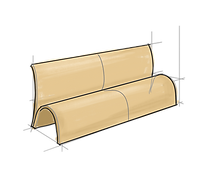

Water Powered Funicular
Design a conceptual funicular that inspires modern use of low-tech public transportation using water weight to eradicate or decrease the electricity that is used to run the system
What is a funicular?
System of two balanced cars that transport people or goods up and down a slope using a pulley system
Due to the weight balance system and ability to use a shared track, funiculars are one of the most energy-efficient methods of transportation.
Modern funiculars mostly run on electricity today, but the first funiculars were water-powered. Water-powered funiculars save much more energy with only a pump needed to send water
to the top of the slope.

Existing Funiculars
Water-Powered Funiculars





Pittsburgh, Pennslyvania
Bergen, Norway
Valparaiso, Chile
Braga, Portugal
Wiesbaden, Germany
Why Water-Powered Funiculars?
Modern funiculars mostly run on electricity today, but the first funiculars were water-powered. Water-powered funiculars save much more energy with only a pump needed to send water to the top of the slope.
Due to the nature of a funicular (with opposite cars approaching the top/bottom at the same rate), fewer resources are required to build a track. Instead of two separate tracks, the cars can share a track with a break only in the middle



Design Inspiration



the design should induce excitement and appeal to modern society
a warm aesthetic is more likely to feel inviting to passengers

passenger accommodations should also be considered and valued



















this design felt simple and adaptable but fluid and complete, keeping a modern, approachable aesthetic
Ideation
Angel Island
Angel Island is the largest natural island in San Francisco Bay. The site features breathtaking views of the bay area and acts as a serene escape from San Francisco's urban area. Previously, the site was home to Native Americans and Spanish explorers. Between 1910 to 1940, the island served as an immigration site for the United States. There is also a strong military history up until it became a California State Park.
Today, the site attracts visitors with its trails, Barracks Museum, tram tours, picnic areas, and views.

"You can hike around the island in 2 hours and have the most spectacular views."
"It's a nice place to spend time with the family. Lots of benches and even suitable for barbeques. If you want to cover the entire island it is better with a bike."
"A few steep trails, trails for bike as well."

Tram Shortcomings
Visitors can't go at their own pace
No wheelchair accessibility
Not everyone has a Bay view
Plan + Section





Creation of a plan view aided in thoughtful consideration of a comfortable aisle width, ample leg room, and enough space to accommodate wheelchairs
Creation of a section view allowed analysis
of the window placement for unobstructed views
on either side along with a subtle display of the water weight feature of the how the funicular functions




Wheelchair Access
Handrails
unobstructed view
handbrakes
water window
water spout
headlights
Personal Item Storage
Features
Other Applications

Angel Island

Bryce Canyon
